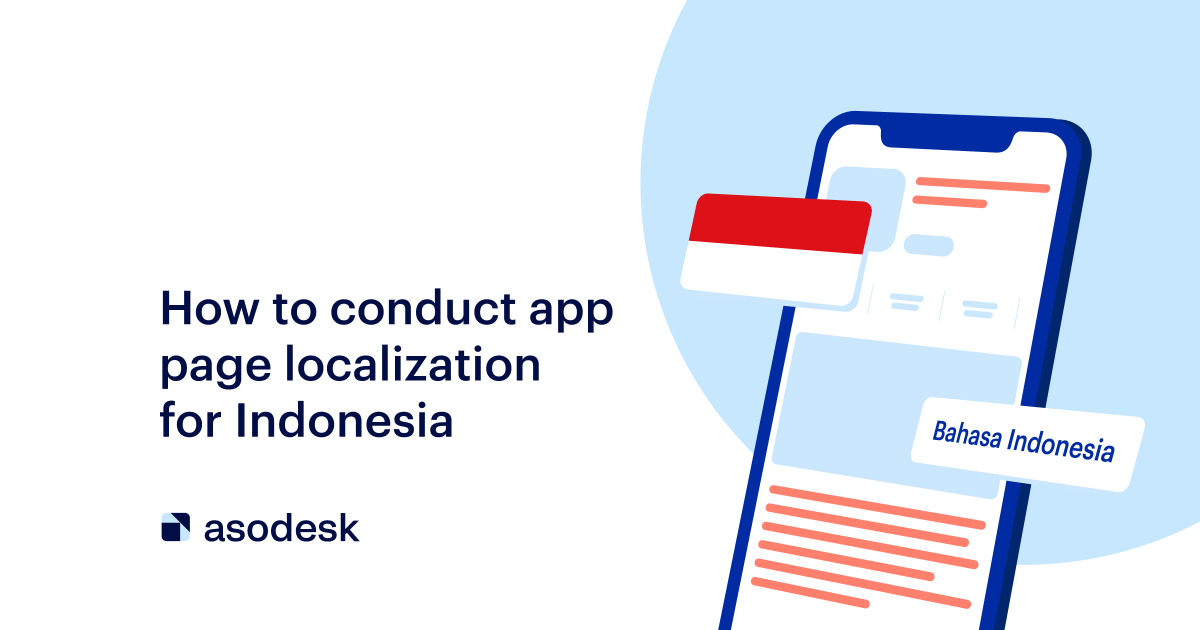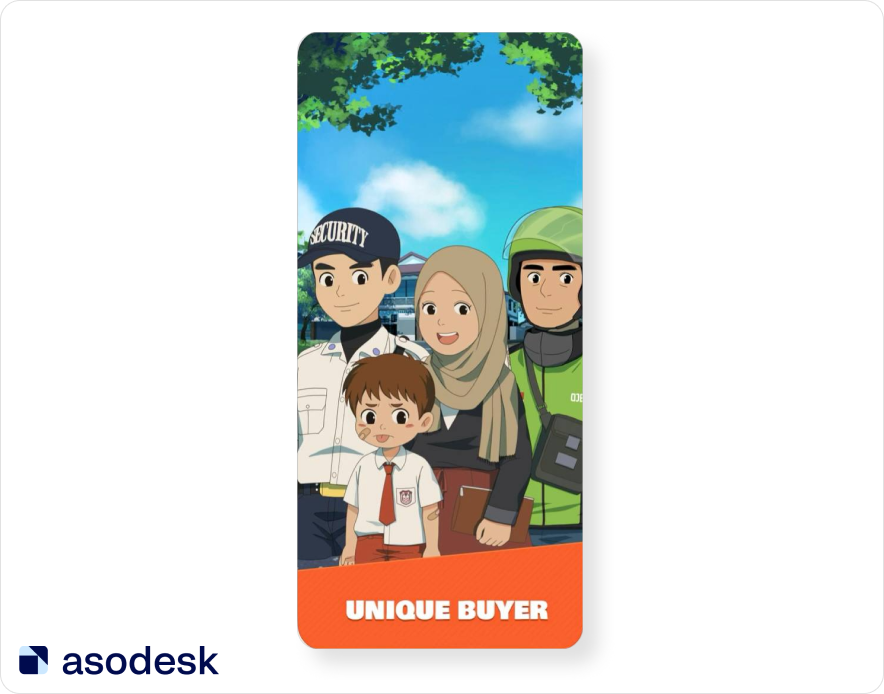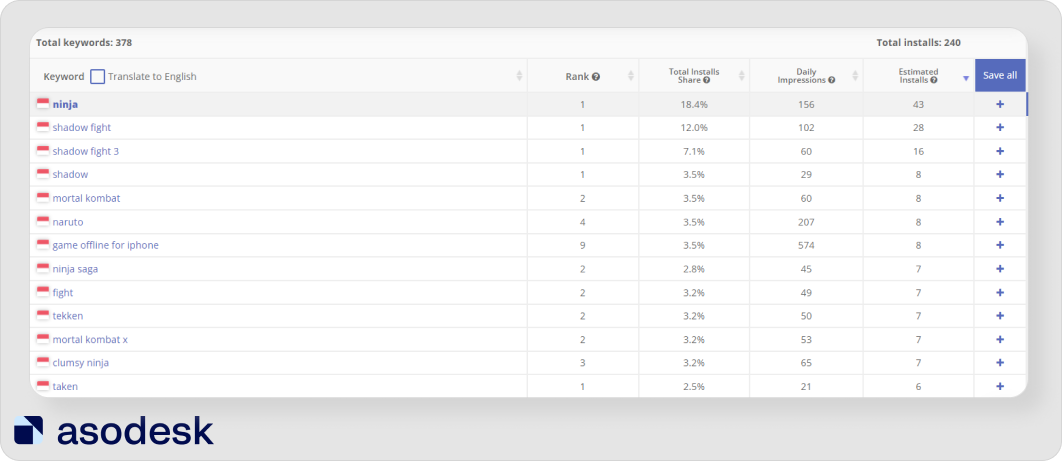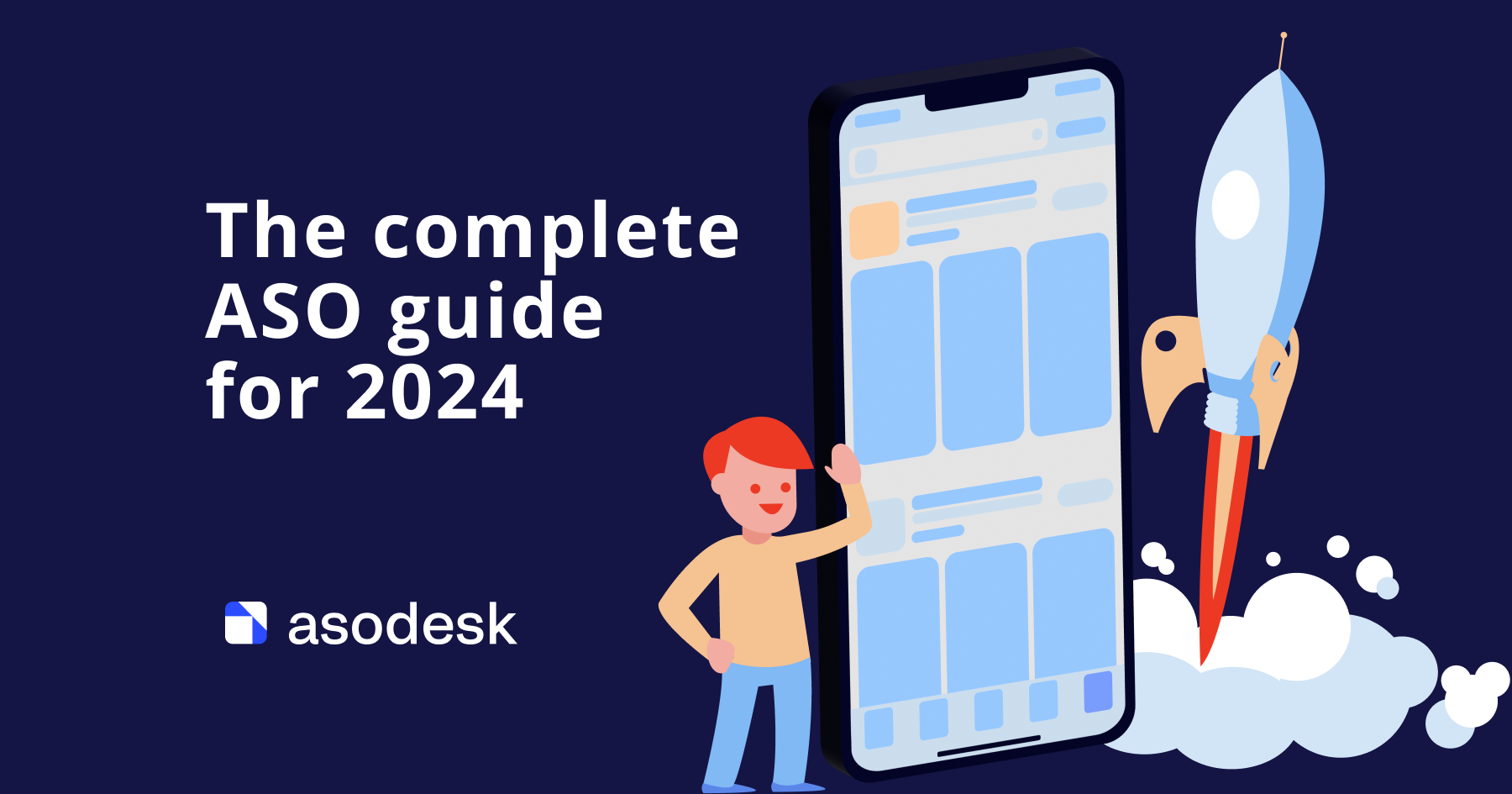How to conduct app page localization for Indonesia

Indonesia ranks 4th in the world in terms of the number of smartphone users, and about 198 million people speak Indonesian. In this article, we will tell you what features should be taken into account when localizing an app page into Indonesian, how to search for keywords, and compile text and visual metadata for Indonesian users.
This is a series of articles about app localization. Previously, we discussed how to localize an app page for Japan, Korea, and other Eastern languages. We also shared how to select countries for promotion in the App Store Search and increase an app’s audience using ASO and mobile app localization.
Contents
Features of the Indonesian culture and market
Selecting keywords for Indonesia
Features of app metadata compilation for Indonesia
Full description for improving an app’s position in Google Play Search
6 main principles of app page localization for Indonesia
Features of the Indonesian culture and market to take into account for app localization
1. Diversity of languages and cultural specificities
In addition to Indonesian, people in Indonesia also speak other languages and dialects, such as Malay, Javanese, Sundanese, Balinese, and Buginese. There are 726 regional languages in Indonesia. Even the native speakers who help me learn the language find it difficult to name all the dialects.
Indonesian is considered to be an intermediary language and a means of interethnic communication among the people of Indonesia. “Unity in Diversity” is Indonesia’s national motto. Because of this, it is very difficult to talk about Indonesian culture as a whole. Sometimes there are more differences among residents from different cities than similarities.
The diversity of cultures in Indonesia is sometimes highlighted in apps and on their App Store and Google Play pages. For example, publishers added a person in a typical Indonesian security guard uniform, a student, a motorcycle taxi driver, and a girl in a hijab to one of the screenshots.

I analyzed the Indonesian audience with the help of a Google Forms survey, completed by 232 people.

The respondents were from the following provinces: East Java, West Java, Jakarta, East Kalimantan, Banten, North Sumatra, and North Sulawesi, all between the ages of 19 and 30.
We learned that 90% of the respondents speak English, 50% speak Javanese and Indonesian, 20% speak Malay, and 10% speak Sundanese.
When searching for mobile apps, 80% use only Indonesian, and 20% use Indonesian or English.
2. Islam prevails in the country
Religion plays an important role in the lives of Indonesians, as it influences their values, morals, and traditions. The government officially recognizes six religions, each of which is practiced by a part of the country’s population:
- Islam — 87%;
- Protestantism — 7%;
- Catholicism — 3%;
- Hinduism — 2%;
- Buddhism — about 1%;
- Confucianism — less than 1%.
Every resident must adopt one of these religions, as religious affiliation is used in official identity documents. Atheism, although not forbidden, is a socially unaccepted ideology, so it is not an option.
Because of the predominance of Islam in Indonesia, you need to be more careful with gambling, showing parts of the female body, male parts of the body between the stomach and the knees, as well as “idols”. You should also be careful with images of animals in visual metadata. For example, Indonesians do not say the word “anjing” (dog). And the word “babi” (pig) is the most offensive for an Indonesian; if you call a civil servant that, you can get a prison sentence.
3. The language is simple, but dialects are easy to confuse
The Indonesian language uses an alphabet based on Latin and has 26 letters. Often, people who are just beginning to learn Indonesian speak of it as a very simple language, in which words are pronounced the same way they are spelled.
However, dialects play a big role. Even in the pronunciation of the simple word “dengan”, you can make two mistakes at once: in “de” and “ng”. And if you say “den” instead of “deun”, the pronunciation will be similar to the Batak dialect.
4. Slow Internet
Indonesia is ranked 99th in terms of mobile internet speed in the world. Take this into account when creating an app: you should optimize its size and work on the speed of content loading.
5. Multiplayer games are very popular
If you look at the 100 most successful games in Indonesia, single-player games occupy only 15%. The CEO of Agate Games, a major mobile game developer in Indonesia, claims that multiplayer games are the future. And those who plan to enter the Indonesian market should take this cultural phenomenon into account.
After this brief introduction to the culture, we will move on to text optimization.
Selecting keywords for Indonesia
To select keywords, you need to focus not only on the Indonesian language but also on Malay. They are similar in grammar but have lexical differences. You can say that Indonesian is Malay with Dutch borrowings.
Ideally, you should opt for the help of professional interpreters and native speakers. If a word or phrase is translated incorrectly by a machine translator, clarify what the word means. That’s how I managed to find a lot of less obvious keywords.
Find different keyword options for your apps with Keyword-Auto Suggestions in Asodesk. With this tool, you can check the most and least popular words for your niche, view the keywords of competitors, and find long-tail keywords. Automatic translation into English will help you understand all of the suggested words.

Solvent Indonesian residents, in most cases, speak English. Therefore, in the search results, you will encounter a lot of English words that you should add to your semantic core.
It is also important to use the Javanese language when compiling the semantic core. It is spoken by over 85 million people — about 40% of Indonesia’s population. You can also include Sundanese (West Java) as it is the second most widely spoken regional language after Javanese. Nowadays, however, it is not so popular among young people who prefer English.
You won’t necessarily find keywords in all languages. Each niche will have its own primary language(s). By the way, it’s okay to mix languages in the text and the keyword field. However, for your convenience, you should make separate tabs for each language. In Asodesk’s Keyword Table, you can create tabs for each language or dialect.

When compiling the semantic core, look for words in Indonesian, Malay, English, Javanese, and Sundanese. Use the Asodesk suggestions to find all keyword variations and translate them into English.

Features of app metadata compilation for Indonesia
When compiling metadata, you should take into account the following features of Indonesian:
1. Strict word order in sentences
The main rule to remember is that the attribute follows the word it defines. For example, permainan seluler is a mobile game.
The demonstrative pronouns “ini” and “itu” may be used as an attribute. We use “ini” when talking about something close to us, and “itu” for something far away or something in the past.
The word order in a general question is the same as in a declarative sentence.
Usually, the subject comes first and the predicate follows the subject.
However, the predicate can stand before the subject; this word order is used to logically emphasize the predicate:
Hitam pénsil ini — this pencil is black.
2. Word repetition in Indonesian
Reduplication is often used in Indonesian: when a word is repeated and changes its meaning. Sometimes the meaning can change quite a lot, for example, “sama” (same), “sama-sama” (you’re welcome).
Reduplication also helps form some plural words, for example, “buku” (book) — “buku-buku” (books).
Many words may not have a plural form; the word “many” can be used instead. This nuance makes the sentences longer.
3. Indonesian is mixed with English
In the Indonesian language, a mix of Indonesian and English words is common among young people. For example, you can write “game seluler” or “game ponsel” (ponsel = telepon seluler), not just “permainan seluler”.
Indonesians like to improvise with the language: mix it with English, local languages and dialects, and add suffixes, prefixes and vocabulary according to religion and social status.
The use of English is considered prestigious, Indonesians perceive it as an indicator of social status. Here’s an example of mixing English with Indonesian:
Sometimes I suka makan nasi with chicken gitu terus pake sambel sama sayur — Sometimes I like eating rice with chicken, and than sambal (sauce) with sauri.
4. Indonesians use a fictional slang language
Bahasa Gaul fictional slang language and abbreviations, such as Gercep (gercep = gerak cepat = move quickly), are used when someone could move faster.
They also use Bahasa Gaul to search for mobile games. For example, the game Garena Free Fire is shortened to “Epep”. “Epep” in slang means “FF” or “Free Fire”. Not all Indonesians can pronounce the “F” sound correctly. Residents of West Java pronounce it as “P”, which is where the shortening came from.


If your target audience is young people, you can also try slang and fictional expressions for your apps. Mixing words from two languages will also allow you to increase the use of keywords. But you should always A/B test, because what works for one app may not work for another.
5. Different variations of pronouns
When you prepare a first-person description of the app, Google Translate will suggest two variations of the pronoun “I”: “saya” and “aku”. Saya is a stylistically neutral variation that is used in both formal and informal communication. Aku is not used formally, only in informal conversations with close people. In fiction, “aku” acts as a narrator.
The pronoun “you” might also raise questions, as it can be translated as engkau and kau. These pronouns are used when addressing close people. However, the pronoun “kau” is practically not used in West Java, since it has a coarse connotation. “Kamu” is used more often in Indonesian speech.
When addressing a stranger, these pronouns are not used. And in advertising, the pronoun “you” is used as “anda”.
6. Add words to make your text sound better
When translating imperative sentences using machine translation, your words may sound rude. To sound nicer, use the words “silakan” (“silahkan”) or “coba” in conjunction with the verb. “Silakan” is more formal than “coba”.
- Silahkan unduh permainannya — download the game (formally);
- Coba kamu unduh permainannya — download the game (less formal).
The sentences are long and using such phrases in the short description is not advisable. Therefore, you can write “download gamenya”, which retains the ending “nya”.
Have you noticed that all the examples have the ending nya? To understand why it was added, let’s look at some Indonesian grammar using the website Indodic, which gives the following example:
- Bukuku — my book;
- Bukumu — your book;
- Bukunya — that book.
These endings are used to indicate to whom or what they refer, as well as the affiliation.
Also, endings are equivalent to English articles in Indonesian.
- Permainan — game;
- Permainan+nya — the game or that game;
- Sebuah permainan — a game.
However, in search, the initial form of the keyword is used more often.

7. Abbreviations
You can use abbreviations to save characters. For example, “a friend” is translated as “teman”, and “friends” are translated as “teman-teman”. But using this spelling is not the best solution. So we can write it as teman2.
ASO specialists are stumped by long sentences that are translated from their language into Indonesian. Google Translate translates the phrase “sounds delicious” as “Kedengarannya menggugah selera”. But if you adapt the translation culturally, you can write it as “kayanya mantap” or “kayanya enak”.
8. Use of legends and idols in visual metadata
The participants of my survey believe that an app can become popular due to three components: the visual appeal of its icon, promotion through influencers, and the presence of cultural elements in the screenshots.
To adapt visuals for the Indonesian market, we can turn to legends and myths from different regions. For example, on the island of Kunti there is a Gua Jodoh cave, from which you can always hear laughing. Some residents attribute this laughter to ghost women with long hair in long white dresses.
Above the entrance to the temple, you can see a fire demon from the forest. The beaches of Java’s southern coast are associated with Nyi Roro Kidul who likes green. And if a man dressed is in green, he will become a servant of the queen and will not realize that he is dead. Such legends can be used in horror games.
The screenshot of this game reflects a common myth that scares children. When the Maghrib prayer is performed after sunset, it is forbidden to leave the house. There are a lot of ghosts outdoors at this time.

These interesting elements allow us to diversify the visuals and become closer to Indonesian users.
9. Use user-generated content for promotion
Indonesians are one of the main creators of content for Instagram Stories, which means that sharing significant moments with other people is important for residents.
For marketers who work with the Indonesian market, user-generated content is an important part of the strategy. It helps strengthen their brand image, increases trust, and does not impose significant financial costs. The developer brand is as important as the game brand.
Full description for improving an app’s position in Google Play
The share of Android users in Indonesia (89.42%) as of August 2022 significantly exceeds the number of iOS users (10.46%). That is why high-quality work with a full description is important as description is indexed by Google Play’s algorithm.
50% of respondents read only Title and Short Description, 30% read the entire description, and 20% answered that they do not read anything because they download apps based on recommendations. Those who read the full description were asked the following question: “What words attract your attention in a game’s description?”:
- information about the large number of capabilities or missions that can be performed;
- the best-selling game in the world;
- interesting game;
- a defined game genre;
- something that evokes intrigue.
Almost all respondents answered that a rating below 3.9 discourages them from downloading the game. The survey participants are also less willing to download the game if the text was not written by a native speaker, even if it was translated by a professional translator. This is due to the fact that translated texts often sound academic and “too correct”, which makes the description unemotional and unappealing.
The Indonesian audience prefers concise materials with relevant information. Therefore, it makes sense not to translate the description, but to compile it from scratch in the desired language. This is especially true for Google Play, where keywords from the description are taken into account in ranking. I’ll share a simple and effective algorithm:
- Check the search results on Google Play for the main keywords.
- Go to the app pages that rank higher than yours.
- Check the descriptions using word-count services, such as Keyword Density Counter in Asodesk.
- Write out the keywords and their repetition count.
- Make a final list of words.
I focus on words that are repeated over 3 times in the text. For example, in one description, the word battle is repeated 3 times, and in the other – 6. And in the final list, we repeated this word 7 times (6+1). We repeated each keyword for better ranking. But for 7 repetitions, the total number of characters in the text must be at least 3000.
To dilute the text, you can use words that you find in Asodesk’s Organic Report on competitors’ pages. This approach showed the best performance in the first scope iteration, as well as when adding keywords to the final description.

After that, create a three-column table. The first column will contain keywords, and the second one will contain the text in the native language. Each line contains only the keys that will be used in the translation. For example, for the first sentence, we selected the following words, each repeated once: “kingdom”, “king”, “enemies”, and “battle”.
We made the following sentences: “King, the enemies are attacking! They crave a battle. Defend your kingdom”. In the third column, the translator translated these sentences separately, based on the keywords: “Raja, musuh menyerang! Mereka menunggu untuk pertempuran. Lindungi kerajaanmu”.
If you translate keys separately to combine them later, be careful. When combining keywords, the word order may be different, for example:
- Daily – Harian
- Rewards – Hadiah
- Daily Rewards – Hadiah Harian
Thus, when writing the full description, it is important to focus on the competitors’ descriptions and, in addition to keywords, to add phrases that may be of interest to Indonesian users.
6 main principles of app page localization for Indonesia
1. Indonesian is a mediator between many local languages and dialects. When compiling the semantic core, you can make several tabs with keywords in Indonesian and its dialects, as well as English, Malay, and Javanese.
2. The main religion in Indonesia is Islam; this should be taken into account in textual and visual optimization. Do not include symbols and words that offend Muslims in your metadata.
3. Young people often mix Indonesian with English, as well as use a fictional language. If you are targeting a young audience, use this to your advantage when compiling metadata.
4. Remember grammatical rules when compiling metadata: the word order, words to make the imperative sentences sound nicer, different variants of pronouns, and reduplication.
5. In visual metadata, you should add user-generated content, as well as adapt ideas from legends.
6. Indonesia mostly has slow Internet, so you need to make apps lighter in size and work on their speed.
In this article, we tried to give you instructions that will help you localize the app page for Indonesia. Subscribe to our newsletter to receive new useful articles on ASO and mobile app marketing.










